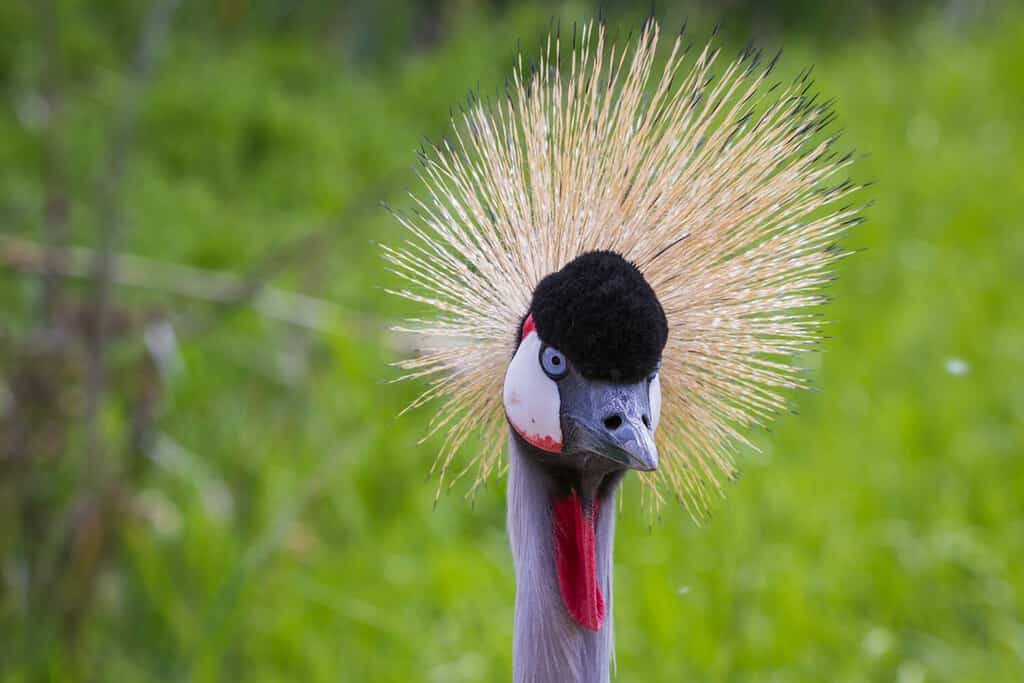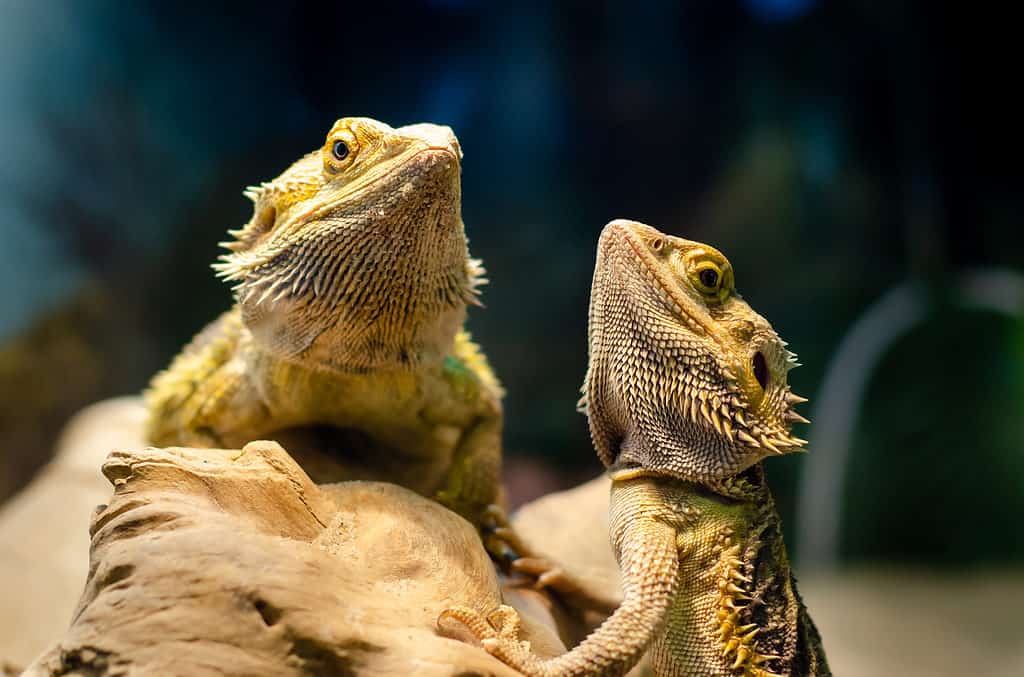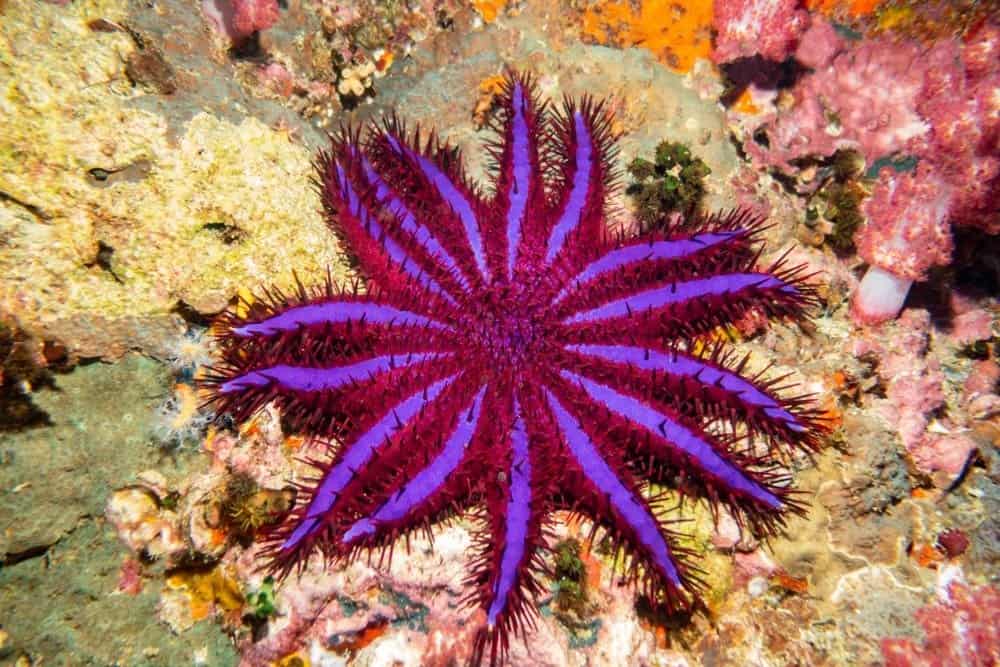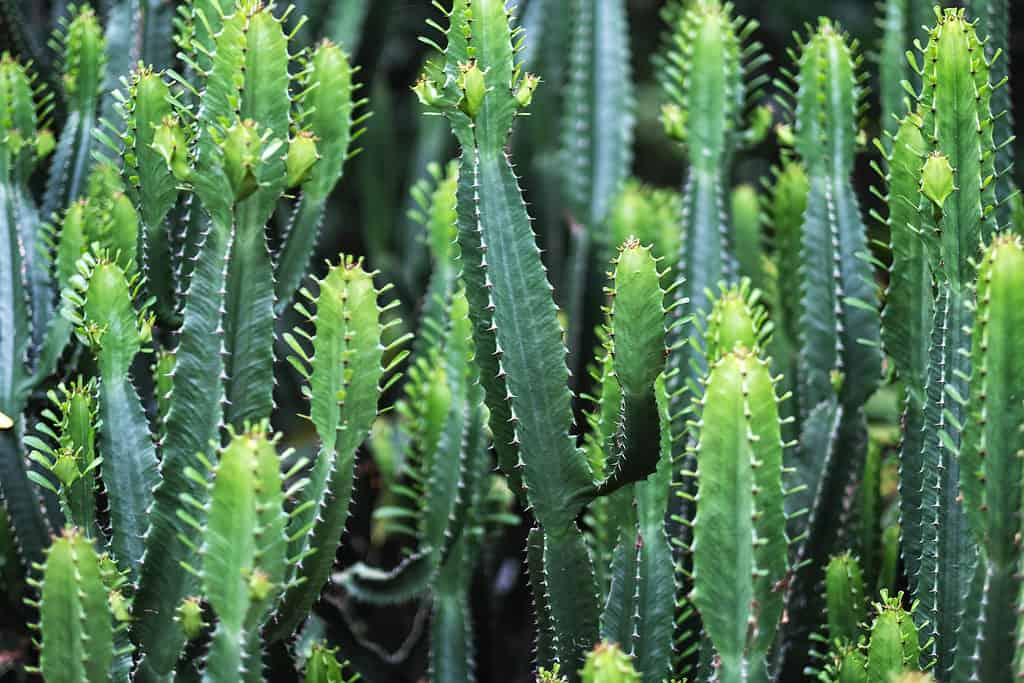Nature has a remarkable ability to create creatures with some of the most unusual and awe-inspiring adaptations. One such adaptation that has evolved in various animals is the presence of spiky bodies. Spiky animals have developed unique protection methods, camouflage, and communication, from the formidable porcupine to the prickly hedgehog. But did you know there are also spiky birds, sea creatures, insects, and even plants?
This article will look closely at some of the most intriguing animals with spiky bodies. We’ll examine the evolution and function of their spines, as well as their fascinating behaviors and ecological roles.
Spiky Animals: Birds
Birds may not have spikes as sharp as other animals, but some species possess unique features. These features resemble quills or spikes, such as spiky feathers or crests.
Gray Crowned Crane (Balearica regulorum)

The gray crowned crane uses its distinctive appearance to attract mates during courtship displays, which involve elaborate dancing and vocalizations.
©Nature’s Charm/Shutterstock.com
The gray crowned crane is easily recognizable. This is mostly due to its spiky crown of stiff golden feathers, which is actually a form of ornamental plumage. The bird’s body is primarily gray, with white wings that feature patches of black and red. Although the crown appears sharp and spiky, it is actually made up of soft feathers and is not dangerous.
The gray crowned crane uses its distinctive appearance to attract mates during courtship displays, which involve elaborate dancing and vocalizations. The species is endangered due to habitat loss and other threats.
Hoopoe (Upupidae)
The hoopoe is found in Europe, Asia, and parts of Africa. It has a beautiful combination of colors. These include a pinkish-brown body, black and white wings, and a long, thin, and curved bill. The most notable feature of the hoopoe is its spiky crown of feathers. The hoopoe can raise or lower the crown depending on its mood or level of excitement. Similar to other “spiky” birds its feathers are ornamental and are not dangerous.
The bird is also known for its distinctive call, which sounds like “poo – poo – poo or hoo – hoo – hoo.” The hoopoe feeds on various insects and other small invertebrates and is considered beneficial to agriculture.
Greater Sage-Grouse (Centrocercus urophasianus)
The greater sage-grouse is known for its unique mating ritual. Males inflate their yellow air sacs, fan their tails, and produce strange sounds to attract females. Male individuals exhibit gray crowns, yellow patches above their eyes, and brown and buff upper chests. They also have a significant white ruff that covers their esophageal sacs, which inflate during the mating ritual.
Females have more cryptic plumage with gray and brown mottling and lack the esophageal sacs of males. They also have a predominantly gray and white throat and a shorter tail. Habitat fragmentation and development have caused severe declines for the species, leading to a “Near threatened” status.
Spiky Animals: Mammals
Several different mammals are covered in sharp quills, spines, or prickles. These structures are a natural defense mechanism, protecting them from predators and other potential environmental threats.
Porcupine (Erethizon dorsatum)

When threatened, a porcupine raises its quills and lashes out with its tail, embedding them in its attacker’s flesh.
©Warren Metcalf/Shutterstock.com
Porcupines are large, slow-moving mammals covered in thousands of sharp, barbed quills, serving as their primary defense mechanism against predators. The quills can reach up to 13.7 inches long in some species. They also have modified hairs that are coated in a thin layer of keratin, the same material that makes up human hair and nails. The quills are barbed, making them incredibly difficult and painful to remove.
When threatened, a porcupine raises its quills and lashes out with its tail, embedding them in its attacker’s flesh. It may come as a surprise, but it is not rare for even large and formidable animals such as lions to succumb to injuries inflicted by these wounds. Unlike popular belief, porcupines cannot shoot their quills, but they are easily detached and may remain embedded in the attacker’s skin.
So, if you come across a porcupine in the wild, run away in the opposite direction!
Hedgehog (Erinaceinae)
Hedgehogs are small, nocturnal mammals covered in sharp spines or quills, protecting them from many threats. The spines are modified hairs that are made of keratin and can be up to an inch long. Hedgehogs can roll into a tight ball, exposing their spines, as a defense mechanism when they feel threatened.
The spines are not poisonous or barbed and do not detach from the animal’s body. Hedgehogs shed their spines regularly and grow new ones throughout their lives.
Echidnas (Tachyglossidae)

When threatened, echidnas curl into a ball, exposing their sharp spines as a warning to potential attackers.
©Greens and Blues/Shutterstock.com
Echidnas, or spiny anteaters, are remarkably unique creatures with a scary feature – their sharp and spiky exterior. These small egg-laying spiky animals, native to Australia and New Guinea, rely on their sharp spines to defend against predators. The spines, made of keratin, can reach up to 2 inches long. But, contrary to popular belief, they do not detach from the animal’s body like porcupines’ do.
When threatened, echidnas curl into a ball, exposing their sharp spines as a warning to potential attackers. They are currently classified as critically endangered due to various factors.
Tenrec (Tenrecidae)
Tenrecs are small, spiky animals with an ancient lineage and were likely the first mammals to land on Madagascar millions of years ago. They have sharp spikes or quills that cover their bodies, which they use for self-defense against predators. Tenrecs also have specialized muscles that allow them to erect and curl their quills, making them more challenging for predators to attack.
While they are similar in appearance to hedgehogs, tenrecs are not closely related to them and belong to their own unique family of mammals.
Spiky Animals: Reptiles
With their sharp, spiky defenses and unique adaptations, spiky reptiles are some of the most fascinating and ancient land creatures in the animal kingdom.
Thorny Devil (Moloch horridus)
The thorny devil is a small, spiky lizard found in arid regions of Australia. Its primary defense mechanism is its spiny body, which provides protection against predators and helps regulate its body temperature. The thorny devil can flatten its body and puff itself up, making it more difficult for predators to swallow. It can also change color to blend in with its surroundings.
The thorny devil has adapted to its harsh desert environment by absorbing water through its skin and storing it in its body. This lizard also has a specialized tongue to extract moisture from sand and rocks to stay hydrated.
Bearded Dragon (Pogona)

Despite their spiky look, bearded dragons are very docile and affectionate creatures, which is why they make great pets.
©Lutsenko_Oleksandr/Shutterstock.com
The bearded dragon is a type of spiky lizard that is popular in the pet trade. This lizard has many unique qualities, such as its beard, which it can puff up and darken to intimidate predators. Bearded dragons also have many small spikes around their heads and bodies that may look intimidating but are actually soft. These spikes are a mimic defense mechanism to trick predators into thinking they are dangerous. Additionally, the bearded dragon has sharp claws and teeth, and its skin is covered in tough, scaly plates that provide protection. Despite their spiky look, bearded dragons are very docile and affectionate creatures, which is why they make great pets.
Bearded dragons can also change their color to blend in with their surroundings, making them more difficult to spot. This lizard has a unique adaptation that allows it to store fat in its tail, which it can use as a source of energy when food is scarce.
Black Spiny-Tailed Iguana (Ctenosaura similis)
The black spiny-tailed iguana, also known as the “black iguana,” is a species of lizard found in Central and South America. As its name suggests, it has a spiky tail covered in sharp scales that it uses to defend itself.
The spiky tail of the spiny-tailed iguana can break off easily, allowing the lizard to escape from predators. The lost tail will regrow over time, though it won’t be as long or spiky as the original. Interestingly, spiny-tailed iguanas strongly prefer rocky habitats and have been known to dig their burrows in rocky outcrops.
Spiny Chameleon (Furcifer verrucosus)
The spiny chameleon, also known as the “jeweled chameleon,” is a small lizard in Madagascar. It gets its name from the spiny projections on its head and body, which help it blend in with its environment and protect it from predators.
Unlike other chameleons, the spiny chameleon does not change color much. Instead, it relies on its spines and the bumpy texture of its skin to camouflage itself. Its eyes can move independently of each other, allowing it to scan its surroundings for prey and predators. It also has a long, sticky tongue that it shoots out to capture insects.
Spiky Animals: Sea Creatures
The ocean is a mysterious and wondrous place, home to various creatures that have evolved fascinating adaptations to survive in its depths. Among these are some of the planet’s most unique spiky animals.
Crown Of Thorns Starfish (Acanthaster planci)

When populations of these starfish become too high, they can cause significant damage to coral ecosystems by eating large amounts of live coral.
©dvlcom/Shutterstock.com
The crown of thorns starfish is a spiky and intimidating-looking creature found in coral reefs across the Indo-Pacific region. The starfish can grow up to 10-14 inches in diameter and has a multitude of sharp, venomous spines on its upper surface that protect it from predators. These spines can cause severe pain and injury to humans who accidentally come into contact with them.
When populations of these starfish become too high, they can cause significant damage to coral ecosystems by eating large amounts of live coral. As a result, efforts to control these populations have been undertaken by various methods, but they continue to pose a significant conservation challenge.
Sea Urchin (Echinoidea)
Sea urchins are common marine creatures covered in sharp, needle-like spines that can cause serious injury to humans who accidentally come into contact with them. The spines are attached to a hard, calcareous shell called a test, which can also be used for protection. Sea urchin stings can cause a number of complications, including respiratory failure, paralysis, tissue necrosis, and even death.
Despite their dangerous nature, sea urchins are considered a delicacy in many cultures and are used in a few dishes, such as sushi and pasta. They are also important in maintaining the health of marine ecosystems by grazing on algae and helping maintain coral reefs. In addition, sea urchins are used in research to study embryonic development and gene expression due to their relatively simple genome.
Red Lionfish (Pterois volitans)

The red lionfish is considered an invasive species in some areas.
©Greens and Blues/Shutterstock.com
The red lionfish, also known as the Pterois volitans, is a venomous marine fish that can be found in the Indian and Pacific Oceans. It has striking red and white stripes and long venomous spines on its dorsal, anal fins, and pelvic. Although the venomous spines of the red lionfish can cause intense pain, swelling, and paralysis in humans, incidents of people being stung by this fish are infrequent and rarely fatal.
The spines can also cause serious injury to marine predators and prey and can even deter some species from approaching the lionfish. The red lionfish is considered an invasive species in some areas, and its introduction to new environments can have devastating ecological consequences.
The lionfish has significantly threatened the Atlantic Ocean and Caribbean reef systems. It is an invasive species in these regions with few predators to control its population.
Long-Spine Porcupinefish (Diodon holocanthus)
The long-spine porcupinefish is a shy and elusive creature that tends to retreat when approached by divers or other potential predators. Despite their timid nature, they can defend themselves with their sharp and venomous spikes. These spikes are not the only defense mechanism of the long-spine porcupinefish; they also secrete a toxic substance from their skin, making them dangerous. The toxin can be fatal to humans if not treated quickly.
The fish also contains glands that, if consumed, are deadly. However, in some cultures, such as in Hawaii and Tahiti, these fish are considered a delicacy and are eaten. Nonetheless, handling them cautiously and consuming them if properly prepared is important.
Whiptail Stingray (Dasyatidae)
The whiptail stingray is a type of stingray found in tropical waters. With a flat diamond-shaped body and a long whip-like tail, this species is typically gray or brown in color with a mottled pattern on its dorsal surface. Its spines are serrated, which makes them ideal for penetrating and lodging into flesh.
When stepped on, the foot is the most common location for stings, but the venom can spread to other areas of the body, affecting sufferers in various ways, such as causing poisoning, pain, or severed arteries. The whiptail stingray is a bottom-dwelling species that mainly feeds on crustaceans and small fish.
Spiky Insects
Spiky insects are a diverse and fascinating group with various defensive adaptations to survive in their environments. Let’s discuss some of them.
Thorn Bug (Umbonia crassicornis)
The thorn bug belongs to the family Membracidae and can occasionally cause damage to ornamental plants and fruit trees. Its adult body length measures around 0.39 inches and varies in size, color, and structure, especially the male’s pronotal horn, which is more angled and expanded than females.
This species has a unique defense mechanism – a tall, perpendicular, thorn-like pronotum that is a natural deterrent to predators like birds, which mistake it for a thorn. Adults are typically green or yellow, with reddish lines and brownish markings, making them easily distinguishable.
Spiny Leaf Insect (Extatosoma tiaratum)
The spiny leaf insect is a species that only exists in Australia. These insects are well-known for their unique features – the females have spikes all over their bodies that protect them from danger and help them blend into their environment. Females are larger than males, measuring around 7-8 inches, and have short wings, various spines, and extensions on their faces and legs.
The male spiny leaf insects, on the other hand, are smaller, measuring only about 4-4.5 inches, and they do not have as many spikes as the females, except for some on their faces.
Giant spiny stick insect (Eurycantha calcarata)
The Australasian region is home to species of phasmid known as the giant spiny stick insect. These insects are typically colored in a range from light brown to black, and they have a physical appearance that resembles either bark or rotting wood.
They are wingless creatures, and both males and females have spines on their bodies and legs for protection. Like many other phasmids and mantises, the giant spiny stick insect displays sexual dimorphism.
Spiny Devil Katydids (Panacanthus)
Panacanthus is a group of predatory conehead insects that inhabit the nocturnal landscape of the Amazon rainforests in Ecuador. Their bodies are covered in spikes, which serve two purposes: camouflaging them amidst the vegetation they live on and deterring potential predators.
The common names attributed to these insects, such as thorny devil katydid, spike-headed katydid, and spiny-headed katydid, are not specific to a single species and are often applied to multiple species.
Other Spiky Things In Nature
Spikes are not exclusive to animals; several other natural entities exhibit them.
Holly (Ilex)

The leathery leaves of the holly have three to five spines on either side, pointing in alternating directions.
©Nature’s Charm/Shutterstock.com
Holly is often associated with its evergreen leaves and red berries, but its thorns are often overlooked. The leathery leaves have three to five spines on either side, pointing in alternating directions.
Interestingly, mature holly trees lack these sharp appendages on their higher branches. These thorns are actually significant to the plant’s connection to Christmas.
Crown Of Thornes (Euphorbia milii)
The crown of thorns is a climbing shrub originating from Madagascar that typically grows to a height of three to five feet. Its heavily armed branches extend in every direction, requiring support, often seeking out other plants or fences to hold it up.
Despite its beautiful crimson summer flowers, the plant harbors a treacherous network of thorns beneath. The infamous “crown of thorns” was reportedly made by placing a circle of Euphorbia on Jesus’ head. The plant is harmful as its sap can irritate the skin and is toxic if ingested. Eating this plant can cause additional health problems.
Cacti (Cactaceae)

Euphorbia (pictured) plants resemble cacti, but they are succulents with many varieties containing spines and thorns.
©iStock.com/Farknot_Architect
The cactus is a type of plant known for its thick, fleshy stems and spikes. Cacti is a family of plants known as Cactaceae, with around 2,000 species. Cacti are found in various shapes and sizes, ranging from small and round to tall and cylindrical. They also have different types of spines, including straight, hooked, or hair-like, which help the plant in water conservation and defense against predators. It might be hard to believe, but cactus spines have another surprising function of providing shade to the plant.
Some cacti even have spines that are toxic to deter animals from eating them.
Spiky Flowers
Many different species of flowers contain thorns or spikes on the stem and bud. Roses have sharp thorns all over the stem. Sunflowers have thistles on the plant to protect themselves from animals. Many annual flowers have some sort of spike or thorn on the plant to protect them from animals, allowing them to fully blossom and pollinate.
The photo featured at the top of this post is © Nature's Charm/Shutterstock.com
Thank you for reading! Have some feedback for us? Contact the AZ Animals editorial team.






